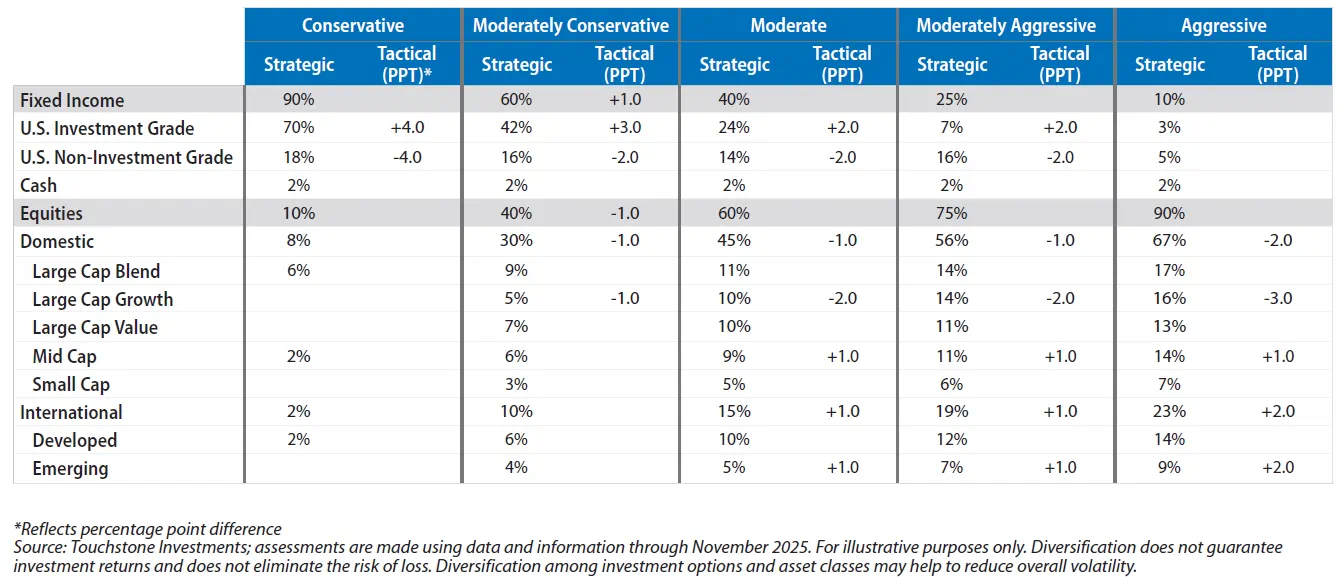Executive Summary
- The outlook for 2026 is being shaped by crosscurrents that are likely to persist. The key question is whether their net effect ends up supporting or pressuring risk assets. For now, we lean modestly bullish but remain at our neutral strategic stock/bond weighting. We are alert to shifts that could change the balance.
- With government data no longer available, we emphasized alternative indicators, which pointed to a slowdown in consumer spending. In response, we made a small tactical adjustment—trimming our economically sensitive mid-cap overweight and reallocating that portion to emerging markets.
- While we do not expect a repeat of 2025’s strong international equity performance, we believe returns can remain competitive with U.S. markets. Europe appears to be emerging from its economic malaise, with earnings poised to rebound, and many emerging-market companies offer an alternative avenue to participate in the AI capacity build-out at much lower valuations.
Fixed Income
Weight: Neutral
We maintain a neutral stance as lower yields and tighter spreads modestly reduce expected returns, but bonds continue to play a critical strategic role as portfolio ballast and a source of stable income.
U.S. Taxable Investment Grade
Weight: Moderate Overweight
We are tactically overweight, drawn by higher yields and lower economic sensitivity, which offer appealing risk-adjusted return prospects relative
to recent history.
Duration
Weight: Neutral
We remain neutral, as we believe interest rate risks have become more balanced. Slowing economic growth could pull yields lower, while sticky inflation and a pendulum swing towards fiscal dominance could push yields higher.
U.S. Taxable Non-Investment Grade
Weight: Moderate Underweight
We are underweight high-yield bonds, given tight credit spreads. However, loose financial conditions, higher index quality, and little sign of distress (in the public markets) reduce the need for a more defensive stance.
Equities
Weight: Neutral
We maintain a neutral weight as we see a balance between equity risk and opportunity. The Fed’s resumption of rate cuts has been received positively by the markets, though policy uncertainty persists.
U.S. Large Cap Blend
Weight: Neutral
Near-term correction risk has eased, following strong third-quarter earnings. However, we are not completely out of the woods as we see signs of growing consumer strain.
Growth
Weight: Moderate Underweight
We are underweight Growth due to elevated stock-specific risks among top constituents – including valuations that seemingly require continued earnings surprises and upward revisions to justify them. Performance has also diverged sharply across the Mag-7 over the past month
Value
Weight: Neutral
We maintain our neutral weight to Value. Greater economic sensitivity and limited valuation support are balanced by sector-specific opportunities in oversold Healthcare, and in Financials supported by deregulation and a steeper yield curve.
U.S. Mid Cap
Weight: Slight Overweight
We reduced our mid-cap overweight, following signs of weakening consumption. Within mid-caps, we prefer high-quality companies with strong cash generation.
U.S. Small Cap
Weight: Neutral
We have a neutral weight. Third-quarter earnings were strong with top-line upside the driver, however, softer labor conditions and uneven demand suggest patience is warranted.
International Developed
Weight: Neutral
We remain at our strategic weight, supported by reduced currency risk, attractive relative valuations, and lower prospective U.S. returns. However, Europe’s fragmented capital markets and regulatory burdens temper our enthusiasm.
International Emerging
Weight: Slight Overweight
We recently shifted to a slight overweight. EM is benefiting from Fed rate cuts and has meaningful exposure to the less economically sensitive
Technology sector, including key companies within the AI supply chain.
Strategic: Strategic asset allocation is a baseline allocation between asset classes established with a longer term focus and congruent with an investor’s investment goals and objectives. The allocation is meant to optimize the asset mix through methodical diversification in an attempt to maximize return and lessen risk.
Tactical: Tactical asset allocation is differentiated from strategic asset allocation by having a much shorter time horizon and the goal of adding alpha beyond what would be allowed through static strategic weights. Markets tend to be more volatile over shorter time horizons, while longer time frames tend to smooth out that volatility. That enhanced volatility in the short term creates the opportunity for either return enhancement and/or risk reduction by adding to or reducing weights of different asset classes.












